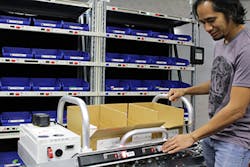Four Picking Options for Your Digital Order Profile
As consumer product companies go digital with orders coming from a growing list of omni-channel sources, order profiles are evolving rapidly. Oftentimes these profiles are reduced to just a few items per order. To meet these changing demands, digital distribution centers are reviewing their picking methodologies to improve efficiency and to quickly get orders on their way to the customer.
Several order picking processes exist that can be deployed in a digital distribution environment, which can be divided into four major categories: discrete order, cluster, zone, and batch picking. Choosing the correct picking strategy for your center depends on a variety of factors, including order size, warehouse size and business need. By taking into consideration the advantages, disadvantages and best practices for each option, your organization can ensure its picking system meets the demands of your digital order profiles.
1. Discrete Order Picking
In a normal distribution center, discrete order picking is the most commonly used picking process. This type of picking is used for one order at a time, with the picker walking the entire picking area for each order. Discrete order picking has the advantage of being simple to learn as well as being accurate even without using a warehouse management software (WMS) system.
Photo: Matthews Automation Solutions
Cluster picking can be achieved more effectively by using a WMS system. The WMS directs pickers through the pick area displaying what to pick and which container to place the item into for the corresponding order. This can also happen in a paper-based warehouse when pick-lists are pre-printed and then manually sorted for like items in the pick area. Paper-based cluster picking is less accurate as pickers may pick or place the wrong item into an order as then try to manage many pick-lists, often a post pick quality control check is used to ensure accuracy – costing efficiency as another process is engaged.
It's most appropriate for digital distribution when handling orders with small cubic dimensions or when your distribution center/pick area is small enough for a picker to efficiently walk through. It also helps to have a WMS system that can direct the picking and putting of many orders at one time in an efficient path.
3. Zone Picking
Batch picking is the best option for digital distribution when a small number of items (web-promotional items) are common across a large number of orders. It is also best used when automation can be justified by the reduction of employees to process orders in the distribution center.
Conclusion
The transformation to a digital company means order profiles will continue to change, lowering the number of lines per order as consumers order only what they need at that point in time. As the number of lines per order changes, so will the requirements for picking those orders. Picking professionals will need to transform the distribution center and the picking strategies with the changing requirements to meet the demands of the digital distribution age.
Richard Barnes, a principal consultant for WiPro Ltd., is a supply chain expert and master black belt with extensive leadership experience and a strong background in applying people, process and technology to streamline supply chain operations.



